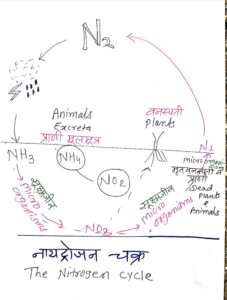9th, Energy Flow in an Ecosystem, Nitrogen cycle 3, 9 वी, परिसंस्थेतील ऊर्जा प्रवाह, नायट्रोजन चक्र 3.
आपल्या मुख्यतः विज्ञान विषयक What’s App समूहात सामील होण्यासाठी🙏 पुढील लिंकला स्पर्श करा🎷
🎻 नायट्रोजन चक्र:-
व्याख्या:- निसर्गात जैविक आणि
अजैविक प्रक्रियांतून नायट्रोजन वायूचे (N2) वेगवेगळ्या संयुगांत घडून येणारे अभिसरण व पुनर्चक्रीकरण ‘नायट्रोजन चक्र’ म्हणून ओळखले जाते.
सर्व सजीव नायट्रोजन चक्रात भाग घेतात.
वातावरणात नायट्रोजन (N2) हा वायू सर्वात जास्त प्रमाणात 78% आढळतो.
निसर्गचक्राचे सातत्य राखण्यासाठी
नायट्रोजनची आवश्यकता असते.
प्रथिने आणि न्युक्लिक आम्ले यांचा नायट्रोजन हा एक महत्त्वाचा घटक
आहे.
इतर अनेक मूलद्रव्यांच्या तुलनेत नायट्रोजन निष्क्रिय आहे व तो सहजासहजी इतर मूलद्रव्यांबरोबर संयोग करत नाही.
बहुतेक सजीवांना मुक्त स्थितीतील नायट्रोजन N2 वापरता येत नाही.
☝️नायट्रोजन चक्रातील प्रमुख प्रक्रिया
अजैविक प्रक्रियांतून नायट्रोजन वायूचे (N2) वेगवेगळ्या संयुगांत घडून येणारे अभिसरण व पुनर्चक्रीकरण ‘नायट्रोजन चक्र’ म्हणून ओळखले जाते.
सर्व सजीव नायट्रोजन चक्रात भाग घेतात.
वातावरणात नायट्रोजन (N2) हा वायू सर्वात जास्त प्रमाणात 78% आढळतो.
निसर्गचक्राचे सातत्य राखण्यासाठी
नायट्रोजनची आवश्यकता असते.
प्रथिने आणि न्युक्लिक आम्ले यांचा नायट्रोजन हा एक महत्त्वाचा घटक
आहे.
इतर अनेक मूलद्रव्यांच्या तुलनेत नायट्रोजन निष्क्रिय आहे व तो सहजासहजी इतर मूलद्रव्यांबरोबर संयोग करत नाही.
बहुतेक सजीवांना मुक्त स्थितीतील नायट्रोजन N2 वापरता येत नाही.
☝️नायट्रोजन चक्रातील प्रमुख प्रक्रिया
- नायट्रोजनचे स्थिरीकरण– नायट्रोजनचे रूपांतर वातावरणीय, औद्योगिक व जैविक प्रक्रियांद्वारे नायट्रेट (NO3) व नायट्राइट (NO2) मध्ये होणे.
- अमोनीकरण– सजीवांचे अवशेष, उत्सर्जित पदार्थ यांचे विघटन होऊन अमोनिआ (NH3) मुक्त होणे.
- नायट्रीकरण– अमोनिआचे (NH3) नाइट्राइट (NO2) व नंतर नायट्रेट (NO3) मध्येरूपांतर होणे .
- विनायट्रीकरण– नायट्रोजनयुक्त संयुगाचे नायट्रोजन (N2) वायूत रूपांतर होणे.
^^^^===^^^^
🚲 The nitrogen cycle:-
Definition:- The circulation and recycling of nitrogen gas into the form of different compounds
through various biotic and abiotic processes in nature is called the nitrogen cycle.
All organisms participate in the nitrogen cycle.
Nitrogen forms 78%, i.e., the maximum portion of the atmosphere.
As compared to other elements, nitrogen is inactive and does not
easily combine with other elements.
through various biotic and abiotic processes in nature is called the nitrogen cycle.
All organisms participate in the nitrogen cycle.
Nitrogen forms 78%, i.e., the maximum portion of the atmosphere.
As compared to other elements, nitrogen is inactive and does not
easily combine with other elements.
Most organisms cannot use the free form of nitrogen.
Nitrogen is necessary for the maintenance of the cycle of nature.
Nitrogen is an important component of
proteins and nucleic acids. Most organisms cannot use the free form of nitrogen.
☝️Important processes of the nitrogen cycle
Nitrogen is necessary for the maintenance of the cycle of nature.
Nitrogen is an important component of
proteins and nucleic acids. Most organisms cannot use the free form of nitrogen.
☝️Important processes of the nitrogen cycle
- Nitrogen fixation: Conversion of nitrogen (N2) into nitrates (NO3) and nitrites (NO2) through atmospheric, industrial, and biological processes.
- Ammonification: Release of ammonia (NH3) through decomposition of dead bodies and excretory wastes of organisms.
- Nitrification: Conversion of ammonia into nitrite and then nitrate.
- Denitrification: Conversion of nitrogen compounds into gaseous nitrogen (N2).
🎷
- पर्यावरणातील सजीवांना जैविक घटक तर हवा, पाणी व जमीन यांना अजैविक घटक म्हणतात.
- जैविक व अजैविक घटक तसेच त्यांची परस्परांशी होणारी आंतरक्रिया हे सर्व मिळून परिसंस्था बनते.
- पृथ्वी ही एक विस्तीर्ण परिसंस्था आहे.
- परिस्थितिकीय मनोरा संकल्पना सर्वप्रथम चार्ल्स एल्टन या ब्रिटिश शास्त्रज्ञाने मांडली.
- पोषण पातळी म्हणजे अन्न प्राप्त करण्याचा स्तर.
- पोषकद्रव्यांचा प्रवाह चक्रीय असतो.
- ज्या सूक्ष्मजीवांना ऑक्सिजनची आवश्यकता नसते, त्यांना विनॉक्सिजीवी म्हणतात.
- बऱ्याच सजीवांना मुक्त स्थितीतील नायट्रोजन वापरता येत नाही.
- जे सजीव वनस्पती व प्राणी या दोघांचाही आहारात समावेश करतात त्यांना उभयहारी म्हणतात.
- हवेतील नायट्रोजनचे रूपांतर नायट्रोजनच्या संयोगात करणे याला नायट्रोजनचे स्थिरीकरण म्हणतात.
- कवक आणि सूक्ष्मजीव हे महत्त्वाचे विघटक आहेत.
- झुरळ, चिमणी, मानव हे प्राणी सर्वाहारी आहेत.
- सूर्यापासून मिळणाऱ्या ऊर्जेच्या केवळ 10 % ऊर्जेचा उपयोग उत्पादक करतात.
- सजीवांच्या मृत शरीरातील सेंद्रिय म्हणजेच कार्बनी पदार्थांचे विघटन करणाऱ्या सूक्ष्मजीवांना विघटक असे म्हणतात.
🥁
- Charles Elton, a British scientist first proposed the concept of the ecological pyramid.
- Only 10% of the energy obtained from the sun is utilized by the producers.
- The pattern of energy exchange in an ecosystem is called a pyramid of energy.
- The flow of nutrients is cyclic.
- Each level in the food chain is called a trophic level.
- Fungi and microorganisms are important decomposers.
- Microbes that do not need oxygen are called anaerobes.
- The earth is the largest and most extended ecosystem.
- The passage of energy in an ecosystem is referred to as one-way transport.
- Those who include both living plants and animals in their diet are called omnivores.
- Cockroaches, sparrows, and humans are omnivores.
- Most organisms do not use free nitrogen.
- Leaving organisms of the environment are biotic components, while air, soil, water, etc, are abiotic components.
✨🌺✨ ✨🌺✨_*या जीवनातकधी कुणाचा काळ असतो,तर कधी कुणाची वेळ असते,आज वाऱ्याने उडणाराकोरडा पालापाचोळा तरकधी कालची नयनरम्यनिसर्गाची पांघरलेली हिरवळ असते.जेथे निर्मिती आहे, त्याचे निर्माल्य सुद्धा ठरलेले असते.म्हणून आयुष्यातील प्रत्येक क्षणाचाआनंद घ्यायला शिका.जीवन हे क्षणभंगुर आहे,त्याला आनंदी बनवा.*_आपला दिवस आनंदात जावो 🎷


